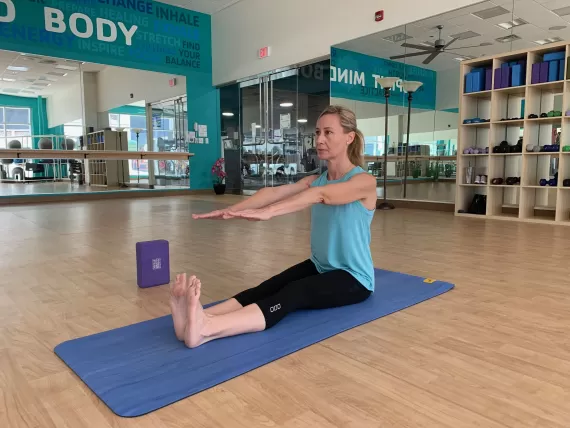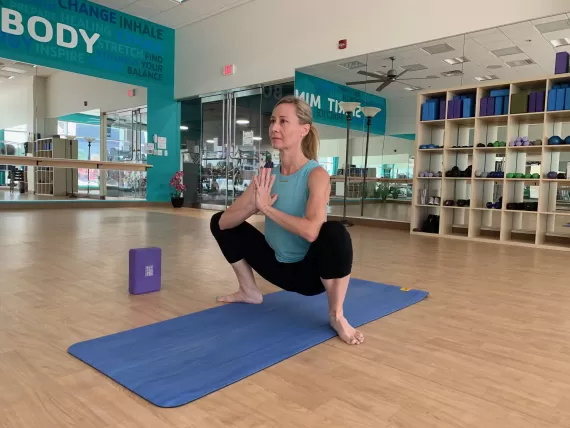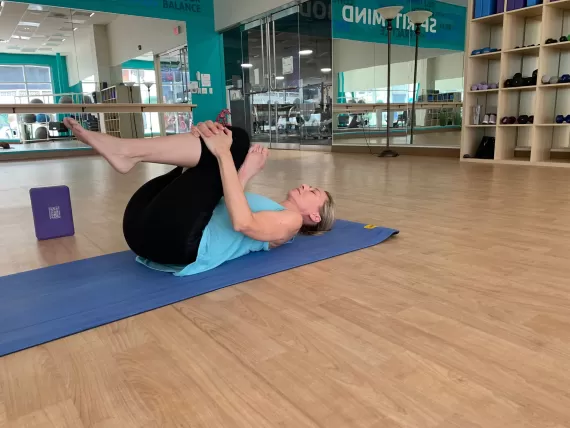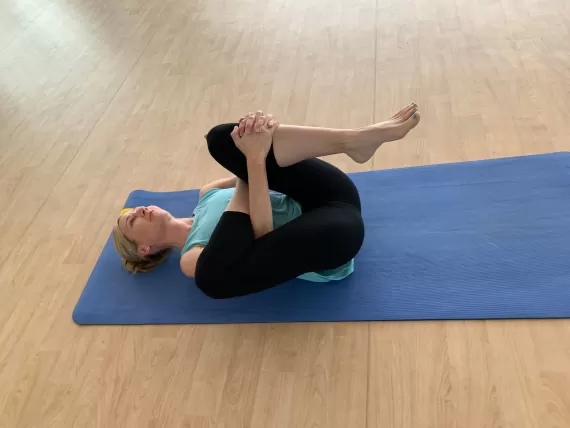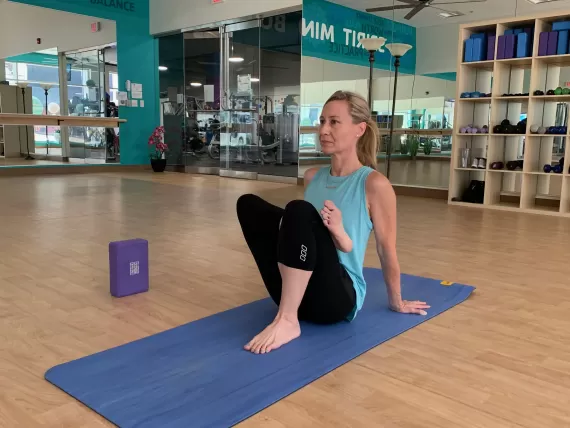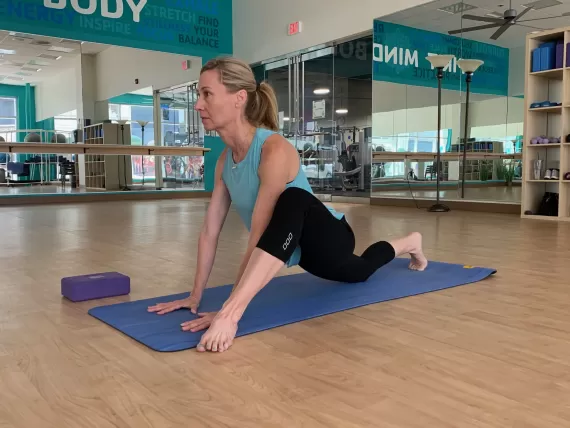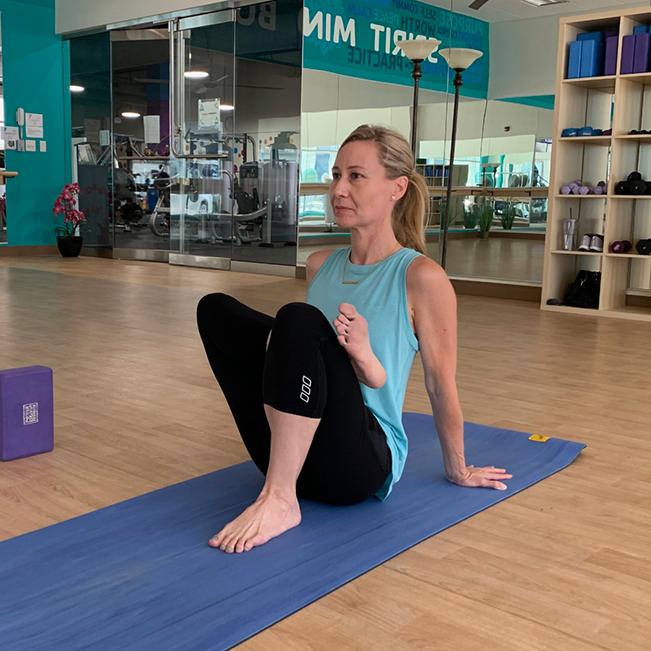
Counteract pounding the pavement with these four yoga poses tailored specifically for runners.
Yoga increases flexibility, strength and balance. All three are necessary for injury free running.
Running can cause tightness and soreness, especially in the lower body. Ongoing tension and
pain can lead to injury. Try to incorporate these four yoga poses following your run or on a rest
day.
Recognize the difference between feeling a stretch and feeling pain. If you feel pain with any of
these poses do not practice the pose. It is likely Pigeon Pose and Lizard Pose will feel different
from one side to another, it might be available to you on one side and not the other. Be sure to
practice any yoga pose on both sides, not just the side you think needs the most attention.
1. Seated Forward Bend: Sit on the floor with your legs long out in front of you. Inhale, and as
you lengthen your torso reach your arms up by your ears. On your exhale, lean forward from
your hips as your reach toward your toes. You do not have to touch your toes or feet to get a
good stretch and you can always keep a bend in your knees. Instead of rounding over in the
spine and trying to get your forehead close to your legs, practice lengthening from the tail bone
to the crown of the head. Think about looking forward with your head raised rather than
looking down at your legs. With each inhalation, lift and lengthen your torso. With each
exhalation, release a little more into the forward bend. If you would like to intensify the stretch
to engage the tops of your upper legs (quads), flex your feet and/or lift your heels off the floor.
This pose can also be practiced with a yoga strap (a belt or towel will also work) by placing it at
the soles of your feet and one side of the strap in each hand.
This pose is primarily for the back of the legs and can be felt in the calves and hamstrings. As
mentioned above, a quad stretch can also be felt. Buttocks, hips and low back also benefit.
2. Squat Pose: Start standing tall at the top of your mat. Heel-toe your feet out to a wide
stance. Your feet/toes are angled out away from your body for this pose. Inhale and reach your
arms up by your ears. As you exhale, drop your hips and bring your hands to your heart center.
The idea is to sink down so your hips are lower than your knees. Slightly press your elbows on
the inside of your knees to open the hips more. Think “chest up, chin up” and try to avoid
rounding over. Your heels do not have to touch the floor to get the benefits of this pose. If you
are interested in working your heels closer to the floor, try moving your feet farther apart from
one another. If you feel like your feet are too wide you can always heel-toe them closer
together.
Squat pose lengthens the spine and strengthens the core. It is a hip opener and stretches the
groin, back, legs and feet. Along with all that stretching, this pose will help increase your
balance.
3. Pigeon Pose: There are three variations of this pose; A: on your back, B: seated (on the floor
or in a chair) and what I will refer to as C: “traditional pigeon pose.” Always do the pose on both
sides, even if you only identify one side as having an issue.
-A: Start on your back with your knees bent, both feet on the floor. Cross your right ankle
on top of your left knee. Work your right knee out to the right side to open the right hip. Next, reach your right arm through the space you made with your right leg and pull your left leg back
toward you (either from the front of your lower leg at your shin or at the back of your upper leg
at your hamstring). If you lift your head, neck and shoulders off the mat you can sneak in a little
core work here. If you really want to feel the stretch in the right hip, keep your head, neck and
shoulders down and pull your legs in toward your chest. If you want even more of a stretch in
your right hip you can slightly press out on the inside of your right leg with your right elbow
and/or flex your right foot.
-B: Start seated on the floor with your knees bent, both feet flat on the floor. Just as on your
back, cross your right ankle on top of your left knee. Work your right knee out to the right side
to open the right hip. Keep your hands and left foot on the floor. Practice sitting up tall in the
pose. If you are not feeling a stretch in your right hip, hamstring, glute area then move your
hands and/or left heel closer to your body leaving your bottom on the floor. Again, you can also
intensify the stretch by flexing your foot.
This same pose can also be done seated in a chair, perfect for those of you who are seated
while at work. Sitting up tall in your chair, make sure you scoot forward enough so both feet are
in contact with the floor. Cross your right ankle on top of your left knee. For more of a stretch in
the right hip, flex the foot or slightly press down on the inside of the right leg with the right
hand. You can also hinge at your hips and lean forward for even more of a stretch.
-C: If you are familiar with practicing three-legged dog then you can enter the pose by sweeping
your back leg through, knee toward the back of your right wrist. If three-legged dog is not part
of your regular practice, enter this pose via table top (hands and knees). Move your right knee
toward the back of your right wrist. Work the outside of your lower right leg down toward the
mat making sure there is space between your right hip and the floor. Allow your right lower leg
to angle down toward your body. Lengthen your left leg long with your foot flipped to touch the
mat. If you are interested in stretching the low back, slowly walk your hands back toward your
body and practice sitting up tall in the pose. However, what most runners look forward to, is
the stretch from hinging at the hips and bending forward. You can be at palms, forearms or
maybe your forehead reaches the floor. It might be comfortable to rest your forehead on your
forearms. If your head touches the floor you can reach your arms out in front of you and stretch
your torso. Be very aware of your right hip and make certain it is not sagging down towards the
floor. If you notice this is happening, you can place a yoga block or a pillow between your body
and the floor to assist in proper alignment. Take your time and return to table top.
Pigeon pose stretches the hip flexors and glute muscles. It is known to relax the piriformis and
psoas muscles. This pose can also help diminish lower back pain and tightness.
4. Lizard Pose (AKA Runner’s Lunge): We will also enter this pose via table top. Step your right
foot through to the top of the mat (you can always take your right hand to the back of your
right leg to help it up). If low lunge is in your practice you can come up into a low lunge before
you transition to lizard. Wiggle your right foot to the right side of your mat. Your foot should be
angled out with your toes hanging off the mat. Place both of your palms on the mat on the
inside of your right foot. Option: work your back knee towards the back of your mat to get
more of a stretch in your left hip flexor (front part). Tuck your back toes under for lizard pose. If
this pose is new to you, stay on your palms with your back knee down. You have the option to
work down to your forearms and/or lift your back knee. You can place your palms or forearms on a block for this pose. Feel free to play with combinations. You might find you feel the most
lengthening if you gaze forward a few feet beyond your mat. If you would like to try an
additional hip opener, practice on your palms with your back knee down on the mat. Slowly and
carefully, roll to the outside of the front/right foot, bringing the sole of your foot up off the
floor. Recognize the difference between a stretch and pain. As with all poses, if it is painful back
off or do not do the pose at all. Remember to practice this pose on both sides.
Lizard pose opens hips and hamstrings. You can feel the stretch in your groin and hip flexors.
Lizard pose can also strengthen the inner thigh muscles. This pose tones your glute muscles and
makes them stronger.
As runners, we are usually focused on the physical benefits of the pose. The bonus is we
can also receive benefits for the mind. All of these poses can help calm your mind and control
stress. Yoga helps us get to know ourselves better, both mind and body. Another benefit for
runners is to practice being comfortable with being uncomfortable.
Julie Christy is a Registered Yoga Teacher for the Gateway Region YMCA. You can find
her at the South City and Downtown MX locations. Her next “Yoga for Runners” workshop is in
partnership with the MO’ Cowbell Marathon. The workshop is free but registration is
requested. http://mocowbellmarathon.com/
